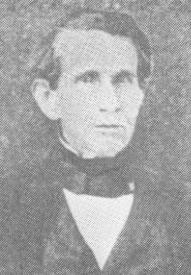Jack Shackelford: Difference between revisions
m Bot: removing misplaced invisible LTR marks and minor changes |
Added and edited information to article introductory paragraph. |
||
| Line 1: | Line 1: | ||
[[File:Dr. 'Jack' Shackelford.jpg|thumb|250px|right|Dr. Jack Shackelford, circa 1845-1850.]] |
[[File:Dr. 'Jack' Shackelford.jpg|thumb|250px|right|Dr. Jack Shackelford, circa 1845-1850.]] |
||
'''Jack Shackelford''' (March 20, 1790 – January 22, 1857) was an American doctor, politician and soldier. He raised and led a unit |
'''Jack Shackelford''' (March 20, 1790 – January 22, 1857) was an American doctor, politician and soldier. He raised and led a unit in [[Courtland, Alabama]] called the [[Red Rovers]] or the Alabama Red Rovers to fight in the [[Texas Revolution]]. He was one of the few survivors of the [[Goliad massacre]].<ref name=Handbook>{{cite web |url=http://www.tshaonline.org/handbook/online/articles/fsh01 |title=Shackelford, Jack |publisher=[[Handbook of Texas]] |accessdate=May 1, 2014}}</ref> |
||
==Early life== |
==Early life== |
||
Revision as of 15:07, 6 December 2017

Jack Shackelford (March 20, 1790 – January 22, 1857) was an American doctor, politician and soldier. He raised and led a unit in Courtland, Alabama called the Red Rovers or the Alabama Red Rovers to fight in the Texas Revolution. He was one of the few survivors of the Goliad massacre.[1]
Early life
Jack Shackelford was born in Richmond, Virginia, to Richard Shackelford. After obtaining his M.D., he moved to Winnsboro, South Carolina, where he opened his medical practice.[2] He married local Maria Young[1] or Youngue.[2]
In the War of 1812, he joined the Army and served on Andrew Jackson's staff, being wounded at Charleston.[2]
In 1818, he moved to Shelby County, Alabama, and purchased a cotton plantation.[2] He was elected to the Alabama State Senate three times, in 1822, 1823 and 1824.[1] However, he was forced to sell his plantation after standing surety for a cousin whose business failed.[1] He was employed as the head of the United States Land Office in Courtland, Alabama, and also as treasurer of the Tuscumbia, Courtland and Decatur Railroad.[1]
Texas Revolution
In 1835, Dr. Jack Shackelford raised a company to fight against the Mexicans in the Texas Revolution. Nearly 70 strong, it included his oldest son, Fortunatus; two nephews; and almost half the men of Courtland.[2] They came to be called the Red Rovers because of the color of their jeans[1] or uniforms.[2] Under the command of Colonel James Fannin, they fought in the Battle of Coleto on March 19–20, 1836. The Texians were defeated and forced to surrender. Most of the prisoners, including Fannin and Fortunatus Shackelford, were executed in the infamous Goliad massacre, but Jack Shackelford and several other doctors were spared to care for the Mexican wounded. During the Mexicans' retreat after their defeat at the Battle of San Jacinto, Shackelford and Dr. Joseph Henry Barnard managed to escape.[1][2] Shackelford was honorably discharged and returned home to Alabama. He wrote of his experiences in "Some Few Notes upon a Part of the Texas War".[1]
Post-Texas Revolution Years
After his wife died in 1842, Jack Shackelford married Martha Chardevoyne.
Death
Dr. Jack Shackelford died in Courtland on January 22, 1857.
Honors
The following year, Shackelford County, Texas, was named in his honor.
References
- ^ a b c d e f g h "Shackelford, Jack". Handbook of Texas. Retrieved May 1, 2014.
- ^ a b c d e f g "Dr. Jack Shackelford". Texas Historical Commission. Retrieved May 1, 2014.
